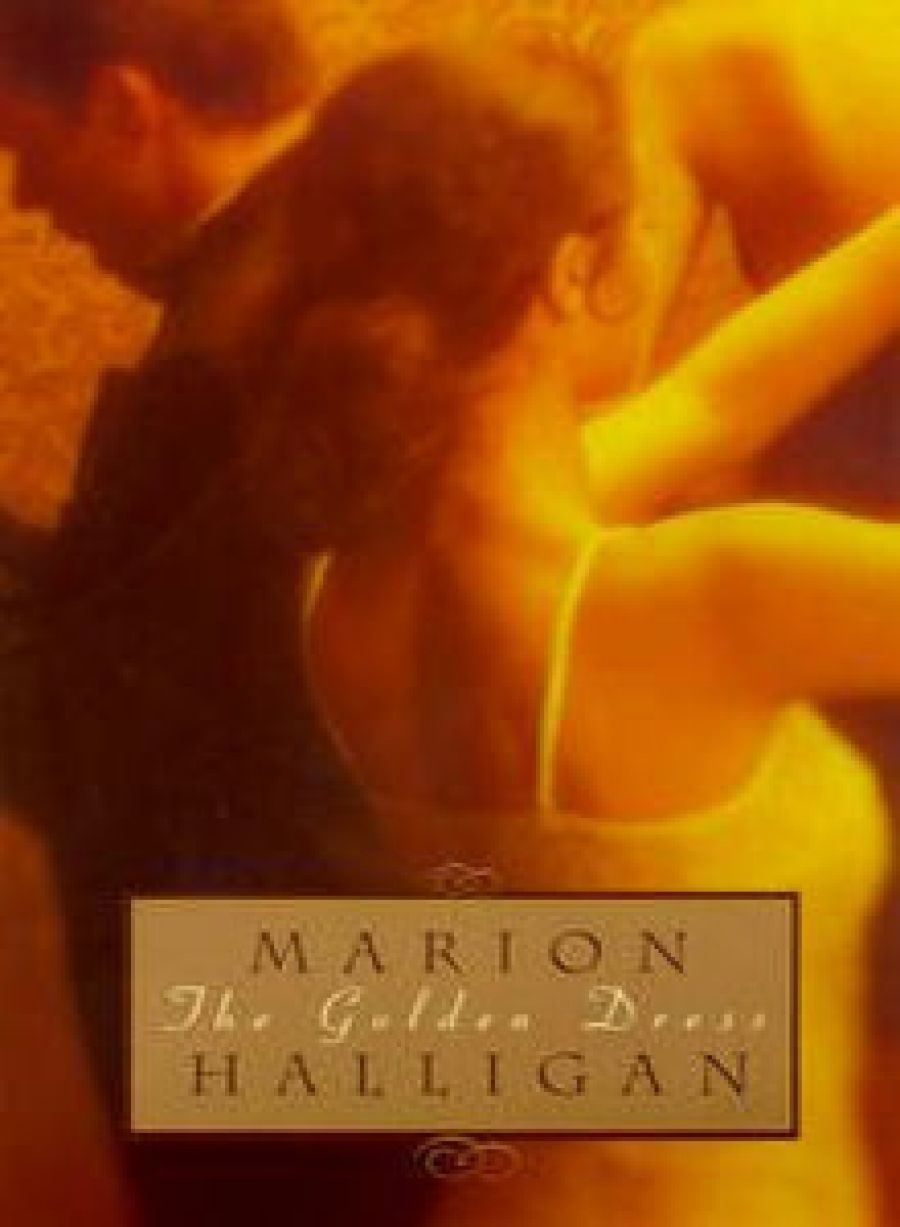
- Free Article: No
- Contents Category: Fiction
- Review Article: Yes
- Online Only: No
- Custom Highlight Text:
Marion Halligan’s new novel has as its centrepiece, shiny and assertive, flagged by its title, a dress made with loving care but, nonetheless, improvised just so that the fabric will go far enough. A dress that Molly Pellerin wears to a party at the laundry where she works, an event that becomes a defining moment in her life, the dress a legacy, offering an image of Molly as dazzling, beautiful, and loved. The photograph sustains her memory, potently, permanently.
- Book 1 Title: The Golden Dress
- Book 1 Biblio: Viking, $19.95 pb, 380 pp, 0 670 87968 1
When Ray thought about the time when his mother was alive it was a yellow colour. The gold embroidered dress might have been part of it, the splendour of it glowing and colouring all its surrounding days. A powerful dress it was in the eyes of those who saw it, even though Molly only wore it once; once was enough. Nobody had seen anything like it … not until the night of the birthday party had anyone considered her dazzling.
This novel is eloquent and affecting. It is complex and, for me, the most satisfying of Halligan’s writing so far. Spanning generations of lives in Newcastle, and stretching across Sydney and Paris, it is full of serious intrigue and delicate investigations of familial matters and intimacy. In one sense, it spins around the repercussions of sexual congress, from Molly Pellerin’s life, all about resultant pregnancy, to the contemporary, more concerned with following desire. The idea of a secret embedded deep in the fabric of a family is compelling, so much so as to even obviate some of the pain of its disclosure. And what is interesting about the way the novel’s many secrets are unfurled is that Halligan doesn’t feel required to make explanations: much is left unresolved.
Sharks and sharkskin. Shark attacks. Boxes made of sharkskin. Shagreen. Chagrin. All of this play with language, with naming, with skin. Skin tattooed all over. Sloughed-off flakes of skin, dead skin, filling up our living spaces as dust. Literally living with the relatives, the dearly departed. The novel is filled with such obsessive details, collections, play with the surface of things, with the conventions of literary production, with invention.
Water. Drowning. Madness. Love. Dancing. The look of things. Particularly painting. Ray Pellerin is a painter, coming to an interest in vision and image as an adult. Martine, his lover, buying a shagreen box at a flea market in Paris, described darkly to her as peau de chagrin, the skin of disappointment. Later, she meets a man in a bookshop in Sydney who might become her lover, a writer who has a book cover that looks like shagreen. He tells her of the novel by Balzac, La Peau de Chagrin. Everything circles around with Halligan; she takes us on an amazing journey through things. Even this potential love affair between the writer and Martine is negotiated through discussions of love narratives, of life and art, and metaphorical possibilities. It’s delicious, but what’s more, also pretty sexy, this moving together and apart, waiting for the rush of desire to force what’ll never happen otherwise. He’s ‘chosen to live in words but Martine sees no reason to be polite about it’.
I heard Halligan read from this novel at a regional writers’ festival in Western Australia before its publication and was struck then by its immediacy of expression, experience, that sense of observing. Martine, the lover, remembering Ray from the time she was an invisible schoolgirl and he a motorcyclist, already in an adult life but still living with his old grandmother. The description and affection that is invested in this relationship between Ray and grandmother, Ivy, is one of the highlights of a novel that follows loss. There are some desperately sad stories of missed connections and opportunities, thwarted love and life, told with a charming, endearing attention, even obsession with language. What you would expect, of course, in a novel about painting and vision and surfaces.
The prose is always well controlled, with that distinctiveness and variety that Halligan manages well; sometimes the surprising declamatory statement is lodged in there. ‘Ray Pellerin sees the majesty of boxes.’ I looked for ages at a word, tinier, trying to understand it, conscious of how things look one way and seem not to connect up at all with their meaning. The descriptions of Martine’s art deco flat in Sydney are gloriously detailed.
And now it is a luminous space of pale walls and the kind of angular shapes of glass and wood that this period made love to. One very big room, a bedroom, a large cold terrazzoed bathroom, and a kitchen made for people who don’t go in for cooking, though it is spacious enough.
There is a lot more artifice here, literary artifice. The conceit of a story within the novel, written by the writer, Tony. The minor differences in tone, the wonderful sense of intrigue in his autobiographical fictions. An interesting way to get to know him, through this piece of writing. There is an everpresent vagabond, or homeless person, or clochard wherever we go in the book, and a fascination with naming and space and the secrecies, the private spaces, that seem possible, implausibly, when living on the street.
The unfurling of stories: I wanted to start from the beginning again as soon as I was finished, now that I had found out so much about these characters. Ray, Ivy, Molly, Martine, St Hubert. And when I did I recognised much more, including the sleight of hand within the narrative, and admired it even further.


Comments powered by CComment